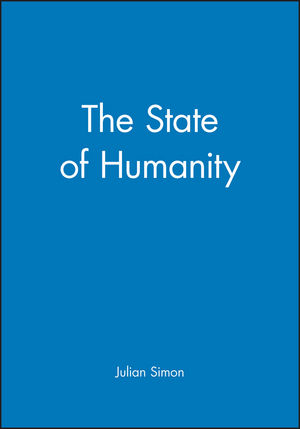The State of HumanityISBN: 978-1-55786-585-4
Paperback
708 pages
January 1996, Wiley-Blackwell
 This is a Print-on-Demand title. It will be printed specifically to fill your order. Please allow an additional 10-15 days delivery time. The book is not returnable.
|
||||||
Part I: Life, Death and Health:.
2. Human Mortality throughout History and Prehistory: Samuel Preston (University of Pennsylvania).
3. The Decline of Childhood Mortality: Kenneth Hill (The Johns Hopkins University).
4. Disease and Health Throughout the Ages: Michael Haines (Colgate University).
5. The Contribution of Improved Nutrition to the Decline in Mortality Rates in Europe and America: Robert W. Fogel (University of Chicago).
6. Trends in Health of the US Population 1957-1989: Eileen M Crimmins (University of Southern California) and Dominique G. Ingegneri.
7. Mortality and Health in the Soviet Union: Murray Feshbach (Georgetown University).
8. Worldwide Historical Trends in Murder and Suicide: Jean-Claude Chesnais (Institute National d'Etudes Demographiques).
9. The History of Accident Rates in the United States: Arlene Holen (Chairman of the Federal Mine Safety and Health Review).
10. World Trends in Smoking: Allan Brandt (Harvard Medical School).
11. Long Term Trends in the Consumption of Alcoholic Beverages: James S. Roberts (Duke University).
Part II: Standard of Living, Productivity and Poverty:.
12. Trends in the Agricultural Labor Force: Richard Sullivan (Holy Cross College).
13. The Standard of Living throughout the Ages: Joyce Burnett and Joel Mokyr (Northwestern University).
14. Long Trends in the US Standard of Living: Stanley Lebergott (Wesleyan University).
15. Long Trends in Productivity: Jeremy Atack (University of Illinois).
16. The Extent of Slavery and Freedom throughout the Ages in the World as a Whole and in Major Sub-Areas: Stanley Engerman (University of Rochester).
17. Black Americans: Income and Standards of Living from the Days of Slavery to the Present: Robert Higgs (Seattle University) and Robert A. Margo (Vanderbilt University).
18. The Long Term Course of American Inequality, 1647-1969: Peter H. Lindert (University of California) and Jeffrey G. Williamson (Harvard University).
19. Trends in Unemployment in the United States: Alexander Keyssar (Duke University).
20. Trends in Costs and Quality of Housing: Richard F. Muth (Emory University).
21. Trends in the Quantities of Education: Julian L. Simon (University of Maryland).
22. Trends in Free Time: John Robinson (University of Maryland).
23. Trends in Poverty in the United States: Rebecca M. Blank (Northwestern University).
24. How 'Poor' are America's Poor?: Robert Rector (The Heritage Foundation).
25. Homelessness in America: Randall K. Flier (City University of New York).
26. The Recent US Economy: Alan Reynolds (The Hudson Institute).
Part III: Natural Resources:.
27. Long Term Trends in Energy Process: William J. Hausman (The College of William and Mary).
28. Trends in the Price and Supply of Oil: Morris A. Adelman (Massachusetts Institute of Technology).
29. The Costs of Nuclear Power: Bernard Cohen (University of Pittsburgh).
30. Trends in Availability of Non-Fuel Minerals: John G. Myers and Stephen Moore (Joint Economic Committee of the Congress).
31. Trends in Non-Renewal Resources: H. E. Goeller.
32. Trends in Availability and Usage of Outdoor Recreation: Robert H. Nelson.
33. Global Forests Revisited: Roger A. Sedjo (Resources of the Future) and Marion Clawson (Resources for the Future).
34. Species Loss Revisited: Julian L. Simon (University of Maryland) and Aaron Wildavsky (University of California).
Part IV: Agriculture, Food Land and Water:.
35. Agricultural Productivity Before the Green Revolution: George W. Grantham (McGill University).
36. Trends in Food Productivity: Dennis T. Avery (The Hudson Institute).
37. Recent Trends in Food Availability and Nutritional Well Being: Thomas T. Poleman (Cornell University).
38. Trends in Grain Stocks: William Hudson.
39. Trends in Seafood Production: John P. Wise.
40. Trends in Soil Erosion and Farmland Quality: Bruce L. Gardner (University of Maryland) and Theodore W. Schultz (University of Chicago).
41. Water Water Everywhere, But not a Drop to Drink: Terry L. Anderson (Political Economy Research Centre).
42. Land Use Trends in the United States: Thomas Frey.
Part V: Pollution and the Environment:.
43. Long Run Trends in Environmental Quality: William J. Baumol (C. V. Starr Centre for Applied Economics) and Wallace E. Oates (University of Maryland).
44. Atmospheric Pollution Trends in the United Kingdom: Derek M. Elsom (Oxford Brookes University).
45. Trends in Air Pollution in the United States: Hugh W. Ellsaesser (Lawrence Livermore National Laboratory).
46. Comparative Trends in Resource Use and Pollution in Market and Socialist Economies: Mikhail S. Bernstam (Hoover Institution).
47. Acid Rain: J. Laurence Kulp (University of Washington).
48. Stratospheric Ozone: Science and Policy: S. Fred Singer.
49. The Greenhouse Effect and Global Change: Patrick J. Michaels (University of Virginia).
50. Greenhouse Scenarios to Inform Decision Makers: Lester Lave (Carnegie-Mellon University).
51. The Hazards of Nuclear Power: Bernhard Cohen (University of Pittsburgh).
52. Pesticides, Cancer and Misconceptions: Bruce Ames (University of California).
53. The Carcinogen or Toxin of the Week Phenomenon: The Facts Behind the Scares: Elizabeth M. Whelan (American Council on Science and Health).
Part VI: Thinking About these Issues:.
54. American Public Opinion: Environment and Energy: William M. Lunch (Oregon State University) and Stanley Rothman (Smith College).
55. Public Opinion About and Media Coverage of Population Growth: Rita Simon.
56. Risk within Reason: Richard J. Zeckhauser (Harvard University) and W. K. Viscusi (Duke University).
57. Natural Ecology Today and in the Future: Kenneth Mellanby. Conclusion: From the Past to the Future.
58. What does the Future Hold?: Julian L. Simon (University of Maryland).
Index.



